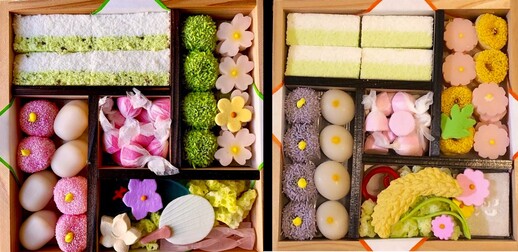2024.06.20
宙ちゃんの「伝統文化一直線」宙ちゃんの「伝統文化一直線」 第7回 四季の美をまとう菓子
近藤宙時=日本伝統文化検定協会理事

京都の老舗和菓子店「亀末廣」の「京のよすが」は季節によって内容が変わる。左から春、秋の商品。
口に入れるのがもったいないほどに美しく、味覚のない胃に送り込むのが惜しまれるほどのおいしさ。日本に生まれてよかったと、茶で口をすすぎながら至福の時に浸ることができるのが、和菓子です。ところで、老舗和菓子屋の跡継ぎが最初に取り組む修業は何だと思いますか?
実は、あんこ作りでもなければ、饅頭(まんじゅう)を丸めることでもありません。正解は、写生です。庭で草木をスケッチし、野山に行って風景を描く。それが、老舗和菓子屋の店主になる人物の最初の修業であり、次の代に引き継ぐ時まで続く日課なのだそうです。外に出て景色を写すことで、四季の移ろいを感じ、自然が描く形と色を知る。そして、その中で自然に根差した美意識を養い、それを菓子作りに生かす―。
和菓子にしかないと思える行事の一つに「お題菓子」作りがあります。宮中歌会始の勅題に沿った、意匠を凝らした和菓子を各店が作り、正月に発表するというものです。お題の他は全く制約がありません。1個幾らの材料費で作ろうが、饅頭でもよければ干菓子でもよく、色も形も自由です。自由なだけに店主の美意識だけでなく、教養から人格までが菓子に表れかねません。作品を持ち寄って品評会を開くこともあるようですが、そこでの批評よりも、お題菓子を楽しみに買いに来る客の、口には出さない感想が一番怖いといいます。通人たちの舌や目、教養に裏打ちされた感性にまで意図を伝え切れるかどうか。まさに和菓子職人の腕の見せどころです。
この行事を可能にしているのが、先に述べた店主の写生です。もっと言えば、普段は特に意識されることもない、自然に根付いた日本人の美意識と、織部焼(おりべやき)に象徴される自由奔放さだと思います。型を踏まえた上での型破り。それを端的に楽しめるのが、お題菓子です。
お題菓子だけではありません。どの和菓子も季節を教え、その季節をより深く味わわせてくれます。正月の花びら餅。春の桜餅や三色団子。端午の節句には粽(ちまき)に柏(かしわ)餅。夏には水羊羹(ようかん)、葛切り、ところてんが火照った体に涼を与えてくれます。栗きんとんを食せば、豊穣の秋が来たことを知ります。饅頭や打ち菓子、羊羹など、季節を問わない年中菓子さえもが季節によって姿や味の趣を変え、四季を楽しませてくれます。
写真は、京都の御菓子司(おんかしつかさ)亀末廣の「京のよすが」です。地元では「四畳半」として親しまれ、年に14回、がらりと装いを変えることで知られます。有平糖(ありへいとう)、寒氷(かんごおり)、求肥(ぎゅうひ)餅、練り切り、落雁(らくがん)、州浜(すはま)、松露(しょうろ)、雲平(うんぺい)、片栗、そぼろ、種あわせ…。それぞれ別個の最高の技術で作られ、姿も味も全く異なりますが、それらが一体となって京都の四季の移ろいをまとうのです。
ちなみに亀末廣には、「京の土」という大きな麩(ふ)焼きせんべいもあります。こちらは一見すると、その名の通り菓子には思えないほど枯れた姿をしています。印象派を思わせる色鮮やかな菓子から、まるで水墨画のような菓子まで、いずれにしても和菓子は極めて絵画的な菓子だと言えます。
そういえば、日本の洋菓子は和菓子の絵画的な自由さに感化されてか、いつの間にか世界一美しく、かわいく、おいしくなったと思います。和菓子が世界を魅了する日も近いでしょう。
カテゴリー: 宙ちゃんの「伝統文化一直線」
関連タグ: #和菓子





